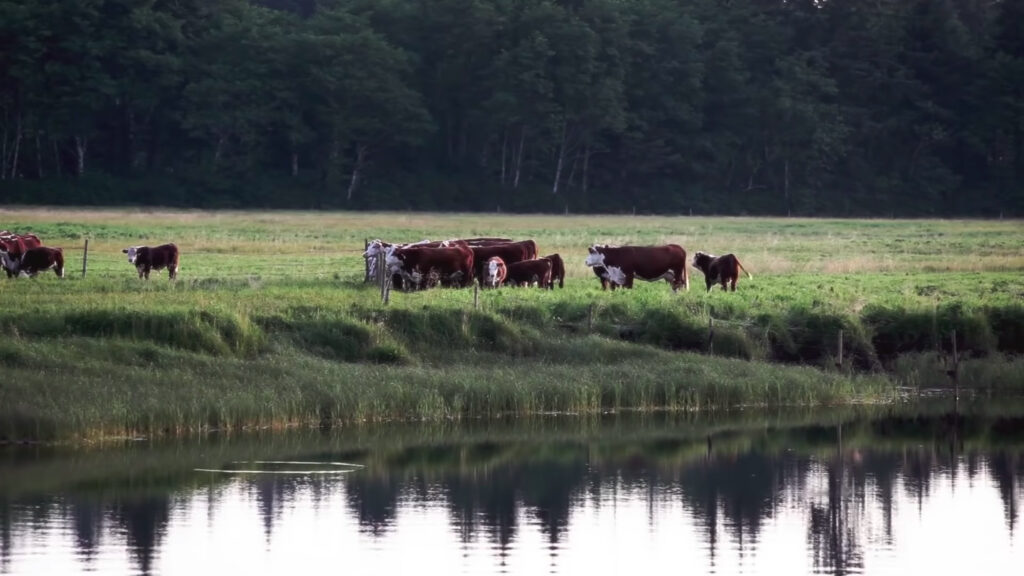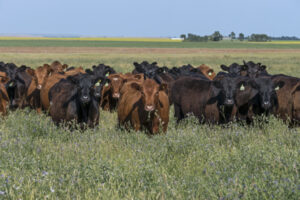Forages for Flood Mitigation🎙️

This article written by Dr. Reynold Bergen, BCRC Science Director, originally appeared in the May 2023 issue of Canadian Cattlemen magazine and is reprinted on BeefResearch.ca with permission of the publisher.
CLICK THE PLAY BUTTON TO LISTEN TO THIS ARTICLE:
Manitoba’s Hydrologic Forecast Centre predicted a major risk of spring flooding along the Red River a few days before this column was written. Spring floods are an annual concern in Manitoba. High precipitation, heavy soils and a flat topography mean that floodwaters can spread with devastating consequences, especially when ice jams prevent meltwater from flowing into Lake Winnipeg.
A cost-effective tool to reduce the impacts of these regular floods may have been there all along. Together with collaborators in Agriculture and Agri-Food Canada and the University of Saskatchewan, Drs. Marcos Cordeiro and David Lobb of the University of Manitoba are leading a Canadian Beef Cattle Checkoff-funded study looking at how forages influence water and nutrient flows. Some of their initial findings were published recently (Simulating the hydrological impacts of land use conversion from annual crop to perennial forage in the Canadian Prairies using the Cold Regions Hydrological Modelling platform; https://doi.org/10.5194/hess-26-5917-2022).
What They Did
This modeling study focused on part of the La Salle River basin west of Winnipeg, a tributary of the Red River. Nearly 90% of this area is agricultural land, primarily seeded to wheat and canola in rotation with potatoes, carrots, soybeans and forage. Daily streamflow data and hourly weather data collected between 1990 and 2013 were obtained from an Environment and Climate Change Canada monitoring site near the study area’s downstream outlet. Annual cropping data was obtained from Manitoba’s crop insurance database for each parcel of land in the four sub-basins nearest the streamflow monitoring site. The growing seasons and growth patterns of different crops (e.g., plant height, water uptake, leaf area, and evapotranspiration throughout the year) were considered, as well as their impact on soil structure. Relationships between cropping patterns and streamflow were adjusted for weather patterns, and used to predict how changes from annual crops to perennial forages would affect streamflow.
What They Learned
Even frozen soil can absorb moisture. How much additional moisture frozen soil can absorb in spring obviously depends on how much moisture was in the soil to begin with, but also by how porous the soil is. Less disturbed soils, like those under zero or minimum till cropping, develop larger and deeper pores that absorb and retain more moisture during spring melt and runoff. But perennial forage stands have additional advantages over both zero-till and cultivated annual crops. The deep roots of many forage plants significantly improve soil structure and soil moisture absorption and retention. Forages also provide greater year-round vegetation cover and take up moisture (through the roots) and release moisture (from the leaves) for more of the growing season than annual crops.
Not surprisingly, perennial forage stands also trapped and retained more snow than annual crop residue. In spite of this, less water ran off from land covered by perennial forages than from annual cropland every year. On average, 36% less water ran off from forage land than from cropland. Peak daily discharges into the La Salle River were 30% lower from land seeded to forage than from land seeded to annual crops. Overland flow was 53% lower on forage land compared to annual cropland.
Research in Saskatchewan has shown that frozen soils covered with perennial forages can absorb water faster than snow melts, but cultivated soil generally doesn’t. In the Manitoba study, land used to grow perennial forage absorbed 66% more moisture than annual cropland.
To simplify the model, the team did not account for either forage harvest or grazing. But either harvesting or summer grazing would remove nutrients from the land, leaving fewer nutrients on the surface for spring runoff to carry off. On the other hand, manure application or winter grazing (especially bale grazing) may add to the nutrient load. In any case, if there is less water leaving the land, it will reduce the amount of nutrients carried off in that runoff. Reduced nutrient losses benefit soil fertility, increase forage yields and reduce the amount of nutrients available to feed algal blooms in downstream water bodies like Lake Winnipeg. Algal blooms are bad for tourism, water quality, and fish, regardless of whether the nutrients come from upstream cities, cropland, or livestock. Other studies in the same watershed have shown that converting annual crops to perennial forages would reduce sediment loads in runoff by 37%, nitrogen by 58% and phosphorus by 72%.
So What Does This Mean…To You?

Whether producers choose to seed forages or annual crops is largely determined by commodity values. But foodservice and retailers’ perceptions and government policies (e.g., cost-effectiveness of crop and forage insurance programs) and regulations can also influence markets and cropping choices. Solid, science-based information like this is important to support Canada’s beef and forage sectors ongoing efforts to share the positive, factual messages about the environmental benefits of beef and forage production in Canada.
Bottom line: Forages can play a key role in moderating the water cycle and reducing flood risks. Grazing cattle have also been shown to reduce the risk of wildfires in BC, and well-managed rangeland supports soil carbon sequestration across the country. Wetlands support migratory birds, and grasslands support wildlife habitat. Cattle are a nature-based solution.
The Beef Cattle Research Council is funded by the Canadian Beef Cattle Check-Off. The BCRC partners with Agriculture and Agri-Food Canada, provincial beef industry groups and governments to advance research and technology transfer supporting the Canadian beef industry’s vision to be recognized as a preferred supplier of healthy, high-quality beef, cattle, and genetics.
Click here to subscribe to the BCRC Blog and receive email notifications when new content is posted.
The sharing or reprinting of BCRC Blog articles is typically welcome and encouraged, however this article requires permission of the original publisher.
We welcome your questions, comments and suggestions. Contact us directly or generate public discussion by posting your thoughts below.